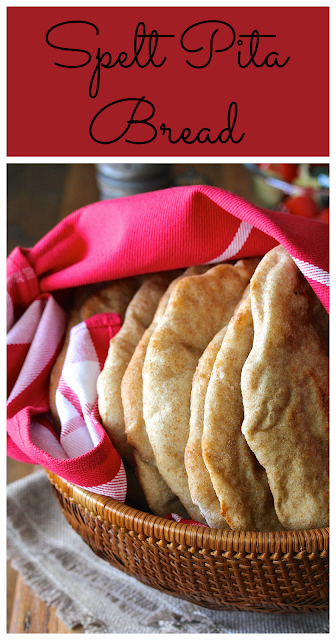Baking pita bread requires a super hot oven equipped with a baking stone, and a very short baking time. If you are like me, and love staring through the window of your oven as your bread bakes, you will enjoy making this bread.
What is spelt you ask? It is an ancient wheat, cultivated since 5000 BC, and it has a lovely mild flavor.
You can use whole grain spelt flour, or mill your own from spelt berries. I mixed the flour with all purpose spelt flour, but you can use also use bread flour.
I milled this spelt in my Wondermill Grain Mill, which, if you ever want to mill your own grains, I highly recommend. It's really fast. Just be sure to read the instructions carefully so you don't spray flour all over your kitchen like I have done. If you have a KitchenAid, you can also get a MockMill, which attaches to the head of your mixer. While it's much slower, the footprint is smaller, and it's pretty cool.
The pocket of pita bread is dependent on high heat and a really thinly rolled dough. It's really fun to watch the pitas puff up in the oven.
If you don't want to go the spelt route, I have a recipe for pita bread with whole wheat flour or sourdough pita with whole wheat, white flour, and corn meal.
What to do with leftovers? Make garlic pita chips!
Spelt Pita Bread
Ingredients
- 432 grams whole spelt flour
- 248 bread flour or all purpose spelt flour
- 503 grams water
- 3/4 tsp instant yeast
- 2 1/2 tsp salt
Instructions
- Combine the flours and water in the bowl of a stand mixer. Mix until just combined. Cover with plastic wrap and let rest for 20 to 30 minutes.
- Add the salt and the yeast. Mix on low for 3 minutes and then mix on medium for 2 minutes. You can also knead by hand for about 5 minutes. The final dough should be fairly firm and smooth.
- Cover the dough and let rise for about 90 minutes, folding at 45 minutes.
- Turn the dough out onto a lightly floured surface and divide it into 12 pieces. Roll each piece into a ball, place the balls onto a lightly floured surface, and cover the dough with a damp towel or oiled plastic wrap. Let rest for 30 minutes.
- Flatten each ball with a lightly floured rolling pin into a 1/8 inch thick disk. Let the disks rest on a floured couche or parchment paper, covered.
- Preheat your oven to its highest temperature with a baking stone on the center rack.
- Transfer the disks to the baking stone with a lightly floured baking peel, three at a time, and bake for two minutes on one side, until puffed, and then flip to bake two minutes on the other side.
- Cool the the pitas on a wire rack for about a minute, and then wrap and stack in a tea towel to keep moist and warm while the other pitas bake.
- Store the cooled pitas in plastic bags to keep them from becoming brittle. I wrapped leftovers individually in plastic wrap and stored them in the freezer.
This recipe has been adapted from the amazing book From the Wood Fired Oven by Richard Miscovich, and contributed to the Artisan Bread Bakers group with permission from the author by my friend David from Hearth Baked Tunes (blog no longer active).







oh I don't think leftovers would be a problem! yourpitas look perfct
ReplyDeleteThanks so much!
DeleteWonderful recipe Karen! Spelt is making a comeback in the last few years here in Greece as well, and having learned A LOT from your posts we're getting better at baking:)
ReplyDeleteThanx so much for another fantastic recipe!
I know this is an old post, but I had to thank you for this wonderful recipe! I made them today and can say with great confidence, it is the best pita bread I have tasted. I did not deviate at all from your recipe and the results were outstanding.
ReplyDeleteThanks so much LouAnne! This makes me happy!
DeleteHello. Can I place the pita bread in the oven without using a baking stone? Thanjs
ReplyDeleteI have not tried it without a stone. do you have a cast iron pan? You could preheat that and use it, or an oven proof stainless steel heavy skillet.
DeleteI am going to try these today, I was wondering.. this is the only recipe where the flours are mixed with the water and left before adding the yeast, what does this step do? Thanks for all the spelt recipes.. I'm getting into this ancient grain!
ReplyDeleteHi Swapna, that is called autolyse, and it helps the flour, especially whole grain flour, absorb the water before adding salt and yeast. It can also help develop gluten.
Delete